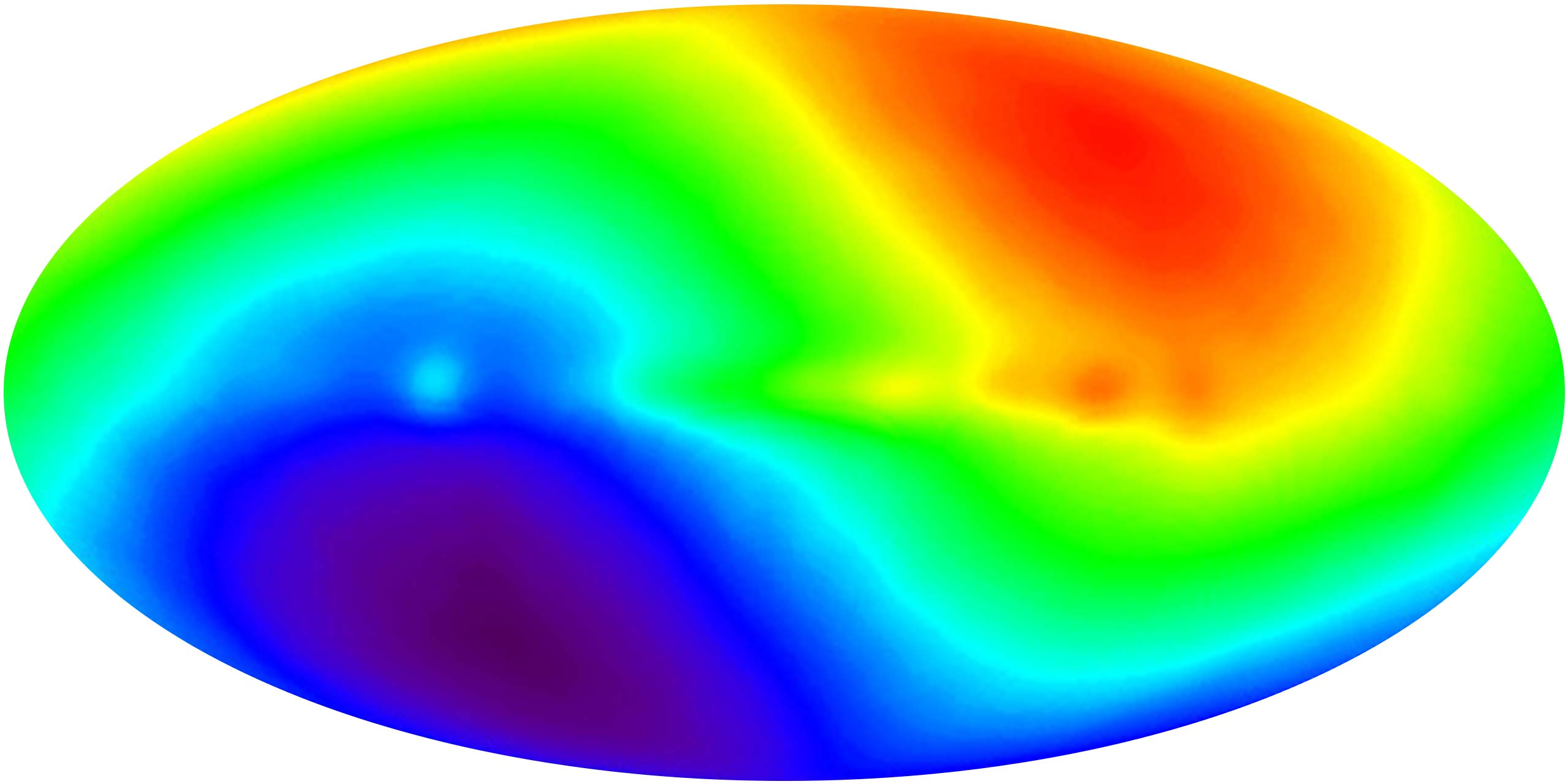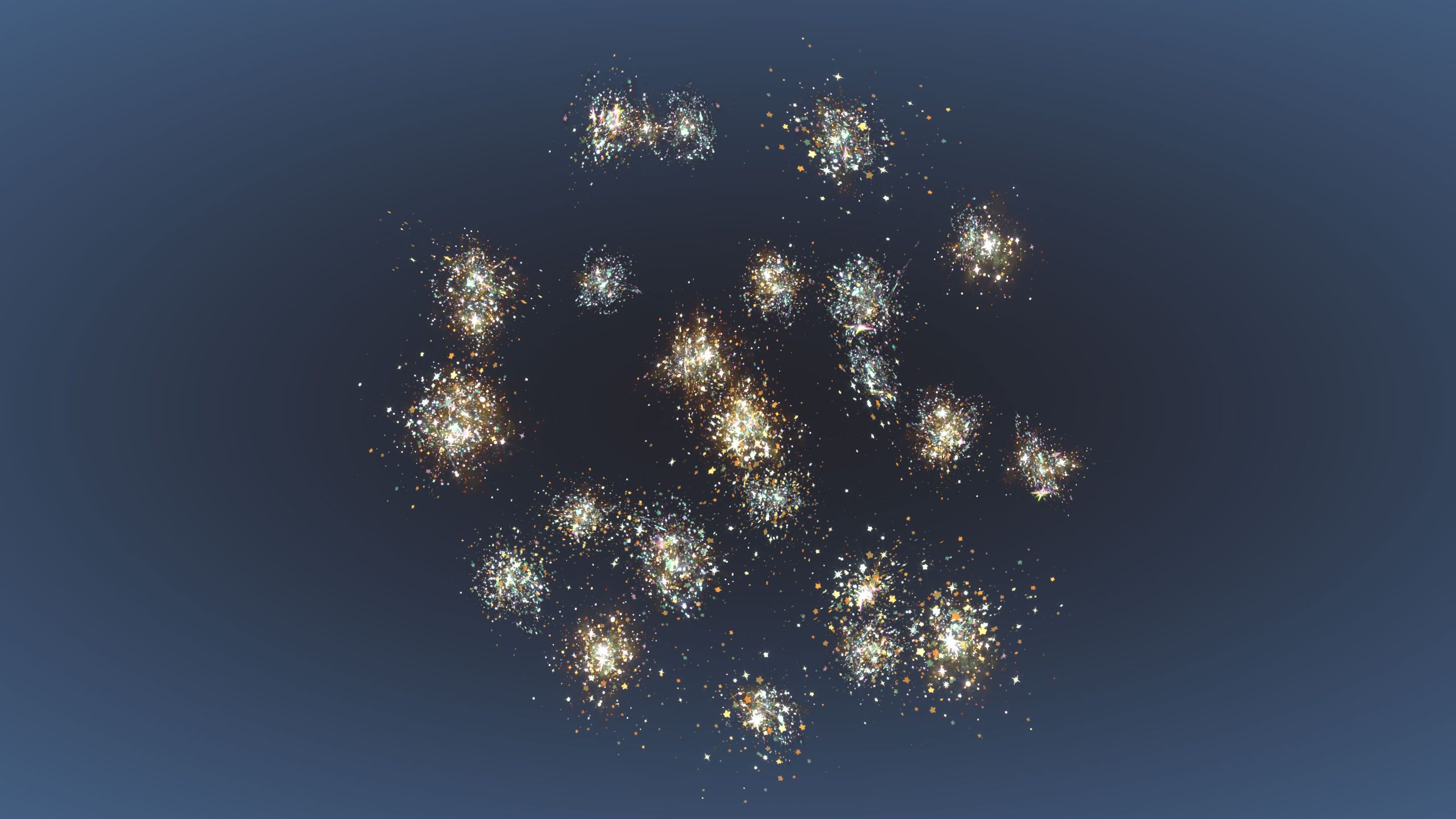Cosmologists Parry Attacks on the Vaunted Cosmological Principle
Introduction
The latest attempt to rattle the foundations of cosmology appeared as a smattering of dots pulled upward into a cosmic sneer. The arc of distant galaxies, which Alexia Lopez presented at the American Astronomical Society’s meeting in June, sprawls so far across the sky that it would take 20 full moons to hide it. Spanning an estimated 3.3 billion light-years of space, the smile-shaped structure joined a controversial club: unexpectedly big things.
“It’s so big that it’s hard to explain with our current beliefs,” Lopez, one of the astrophysicists at the University of Central Lancashire who identified the galaxy chain, said during the presentation.
Lopez’s “Giant Arc” seemed to clash with an idea that has guided astronomy for centuries: that the universe has no conspicuous features. From a zoomed-out perspective, no matter where you are or which way you look, you should see roughly the same number of galaxies pinwheeling around.
This assumption, enshrined as the “cosmological principle,” has let researchers draw sweeping conclusions about the whole universe based only on what we see from our corner of it.
“If that turns out to be wrong, then we have to redo many of our measurements or reinterpret many of our measurements,” said Ruth Durrer, a cosmologist at the University of Geneva.
As a load-bearing strut of modern cosmology, the cosmological principle has increasingly become a target. Some challengers, like Lopez and her colleagues, are astrophysicists puzzled by striking celestial conglomerations. Others are maverick cosmologists unsettled by the consensus view that most of the stuff in the cosmos hides from our instruments in the form of “dark matter” and “dark energy”; they wonder whether theorists may have conjured phantasms to patch up an overly simplistic theory of cosmology.
Most everyone agrees that the cosmological principle is worth scrutinizing. So far, though, each new claim of a too-big structure or other anomaly has failed to make a dent. We are “trying to poke as many holes as we can,” said Seshadri Nadathur, a cosmologist at University College London, “while being very skeptical of someone else saying they’ve poked a hole.”
From Copernicus to Einstein
The cosmological principle grew out of the Copernican principle, Nicolaus Copernicus’ 1543 realization that Earth is not the fixed center of creation. His insight that Earth orbits the sun rather than the other way around set off a series of humbling shifts in perspective. Astronomers proved in the 1800s that the sun is just a normal star. The following century, they spotted countless galaxies beyond our own.
“We’re not special,” said Andrew Howell, a cosmologist at Las Cumbres Observatory and the University of California, Santa Barbara. “The universe keeps telling us that.”
Samuel Velasco / Quanta Magazine; source: A. Lopez/UCLan
Not only is Earth not special, but nothing anywhere is special. Over the past century, astronomical surveys solidified what’s become known as the cosmological principle in two ways. As powerful telescopes peered deeper into the darkness, they saw more-distant galaxies appearing in similar numbers. This suggests that the cosmos is homogeneous, with matter sprinkled smoothly throughout. (Think of the expanding universe as a rising fruitcake with galaxies evenly spread like fruit pieces, each one flying away from its neighbors as the batter between them expands.)
Moreover, telescopes pointed in different directions have all seen similar scenes. Matter is evenly distributed along every line of sight, indicating that the universe is “isotropic.”
The cosmos’s homogeneity and isotropy make it simple enough to analyze.
Theorists reconstruct the cosmos’s past and predict its future using a standard theoretical model based largely on general relativity, Albert Einstein’s theory of gravity. Einstein’s theory describes the interplay between matter and space-time — the bendy fabric of the universe. But Einstein’s treatment involves 10 interlinked equations and 20 variables, a system of equations that is generally too complicated to solve.
Cosmologists lean on the cosmological principle to restrict their focus to a universe acting as a smooth and symmetric fluid. By ignoring bumps of matter like galaxies and requiring the universe to expand in the same way along all three axes, the cosmological principle deletes parts of the equations and links some of the variables, dramatically simplifying the system of equations. Theorists can then predict the velocity and acceleration of the cosmos’s expansion with just two equations — the Friedmann equations, derived from Einstein’s by Alexander Friedmann, a Russian cosmologist, in 1922. It’s a bit like computing the volume of the Earth: You could fret over every mountain and ravine, or you could assume the planet is a sphere and call it a day.
As astronomers map the universe more precisely, however, a few researchers have started to wonder whether the field has pushed the cosmological principle too far. Earth isn’t a sphere, after all — it bulges at the equator. In the same way, large structures or lopsided features could undermine conclusions about the universe’s age, behavior and composition.
Thomas Buchert, a cosmologist at Claude Bernard University of Lyon 1 in France, is among those who have become convinced that it’s time to move beyond Friedmann’s monotone universe. “It’s strange it’s still alive, this standard model,” he said.
Galaxies Everywhere
The Giant Arc and other giant structures strike at the first pillar of the cosmological principle: homogeneity.
The universe is clearly not homogeneous on the human scale. Teleport a person one light-year from here and you’ll ruin their day. But drop the Hubble Space Telescope halfway across the universe, and it will return familiar-looking galaxy-filled images. In this way, the cosmological principle treats the cosmos like the air in an inflating balloon. Up close, molecules mingle in complicated ways. But from far away, a bland gas expands with bulk properties like pressure and temperature changing steadily.
Galaxy surveys have found that any patch of space larger than hundreds of millions of light-years across includes roughly the same amount of matter. So structures like the Giant Arc, which spans billions of light years, are as unexpected as a thick clot of air in an otherwise ordinary balloon.
One of the first of these structures was identified in 2013: a putative grouping of brilliant galaxy cores known as quasars distributed across 4 billion light-years that, its discoverers wrote, “challenges the assumption of the cosmological principle.”
Few others were convinced. Nadathur, the UCL cosmologist, set out to see if randomness alone could create the illusion of megastructures. He simulated digital universes that had galaxies scattered completely haphazardly. Nevertheless, when he set a cluster-hunting program loose on the smooth simulations, it picked out patterns as large as the quasar group purely by chance. Simulated standard-model universes (in which gravity has drawn galaxies together into groups) would contain groupings of galaxies that were grander still. Nadathur’s work suggested that the cosmological principle has plenty of room for the quasar group, the Giant Arc and others of their ilk. Huge structures will be rare, he said, but the standard model “doesn’t say the probability is zero at any scale.”
A more convincing observation of inhomogeneity, according to Nadathur, would be the discovery that matter maintains some lumpiness as you look at larger and larger scales. But studies to date have consistently found that as you zoom out, the universe gets ever smoother.
Durrer and other cosmologists agree that seemingly impossible structures can probably be explained by humdrum statistics. “If you make many, many observations, you will have some of them which are statistically not very probable,” she said. “I’m not very much worried about those.”
Directionless Universe
Even if the universe is homogeneous, it could still single out one direction for something special — an “anisotropy.” In such a cosmos, great streams of matter might flow in that direction like a breeze. A few cosmologists think this might be happening.
Strong evidence against any sort of cosmic flow comes from the afterglow of the Big Bang. Astronomers have determined that this “cosmic microwave background” (CMB) has an essentially identical average temperature of 2.725 degrees above absolute zero in every direction.
But to calculate that temperature, researchers correct for a slight imbalance: The CMB looks a fraction of a degree warmer toward the constellation Aquarius, and a fraction of a degree cooler in the opposite direction.

Light that fills the cosmos from the Big Bang looks slightly warmer coming from one side of the sky than the other, this COBE satellite image revealed in the early 1990s. The distortion is widely thought to result from our solar system’s motion, but a few cosmologists think the whole universe might drift.
Almost all cosmologists interpret this observation as resulting from our solar system’s own motion, known as our “peculiar velocity.” The sun orbits the Milky Way’s center and the Milky Way moves toward nearby galaxies such that our solar system drifts against the background of the CMB at roughly 300 kilometers per second, distorting incoming microwaves. This local drift is not seen as a problem for the cosmological principle.
But our peculiar velocity might not fully explain the perceived lopsidedness of the CMB; the distortion could also include the effect of the whole universe drifting. If this is the case, gauging our motion against distant galaxies will give a different result than if we measure our speed against the CMB, since those galaxies will be moving too. Imagine going for a train ride and measuring your speed against a mountain range and against clouds on the horizon. If the speeds don’t match, the clouds must be scudding over the mountains.
Several teams have attempted such measurements against distant galaxies and found apparent oddities. In one recent effort, researchers calculated our motion against more than 1 million faraway quasars. They observed an optical distortion aligned with the imbalance in the CMB, but twice as large. One interpretation is that the Earth drifts at around 600 kilometers per second relative to the quasars, implying that the quasars may be moving against the CMB.
Subir Sarkar, a cosmologist at the University of Oxford and a member of the group that made the calculation, called the discrepancy a “body blow” to the standard model and its assumption of an isotropic universe. He pointed to speculation that some giant cloud of matter sits outside the observable universe and drags everything toward it. (We can only observe the spherical volume of the universe whose light has had time to reach us since the Big Bang.) “We don’t know what’s outside, and there is a lot outside,” Sarkar said. “Maybe there is a monster lurking there.” That would upend the leading theory of the cosmos’s first moments, which holds that space exponentially inflated, becoming smooth and flat far beyond our observable patch.
Most cosmologists remain skeptical that the quasars prove an off-kilter universe, however. Several researchers interviewed for this article said that various technical challenges, such as the uneven distribution of the quasars, make it tough to compare the quasars with the CMB. “Those studies are pretty hard to do,” said Tamara Davis, an astrophysicist at the University of Queensland in Australia.
Durrer calls the quasar evidence inconclusive and says she is keeping an open mind. She recently devised an alternative test that combines various ways our motion would tweak the appearance of distant galaxies. She and her colleagues calculated that, using their technique, next-generation observatories will be able to pick up peculiar velocities differing by just a few percentage points, allowing precision tests of isotropy and the cosmological principle this decade. They published their new approach in early November.
“This we will be able to resolve,” Durrer said.
Escaping the Background
To keep pace with sharpening observations of the universe, many theorists, in their standard-model calculations, incorporate modest ripples of matter in an otherwise smooth fluid, akin to improving on an estimation of the Earth’s volume by including an assortment of mountain ranges. “You make life more complicated again, but you add the complications in a controlled kind of way,” Nadathur said.
But some, like Buchert, the French cosmologist, want a fuller departure from the assumption that the universe is the same everywhere. To that end, Buchert has spent decades developing a “background-free” model of cosmology.
Einstein’s general relativity theory demolished the classical notion of a background — a fixed stage against which one might measure distances and movements. Instead, it says space-time curves around matter like theater curtains swishing after actors pass by, sometimes making the play’s action hard to follow. The standard model lets space-time bend a bit but uses the cosmological principle to keep the curves small and the expansion rate uniform. In this way, it restores a notion of a backdrop to make calculations feasible.
Buchert’s work does away with the universal background. Instead, he splits the cosmos into large chunks and averages the amount of matter (and the resulting bending of space-time) in each region. He then treats the average as a local backdrop against which to interpret any events taking place inside that chunk — an approach that has turned up an unexpected result.
In 1998, astrophysicists looking at distant supernovas determined that the universe appears to be expanding faster as time goes on. Their Nobel Prize-winning observation implied that some repulsive energy, dubbed dark energy — probably the energy of space itself — is pushing galaxies apart from each other more forcefully than gravity can draw them together.
Buchert’s background-free approach has raised another possibility. Compared to small, dense patches of galaxies, emptier “voids” in space expand faster, since they have fewer galaxies gravitationally attracting and slowing each other down. Since the empty parts grow faster than the dense parts, the universe becomes emptier. And so its overall expansion rate grows. Buchert argues that this effect, called backreaction, could explain the cosmic acceleration without the need for dark energy.
Other cosmologists agree that the background-free treatment is mathematically sound, and that backreaction is real. But is it a big enough effect to kill dark energy? This question motivated Durrer and her colleagues to do a large-scale simulation in 2019. They prepared a digital universe populated with hundreds of billions of galaxies and calculated how differing expansion rates in voids and galaxy clusters would affect light beams headed for a randomly placed astronomer. They found that backreaction would throw off the astronomer’s measurement of the universe’s expansion rate by about 2%. In other words, the standard model predicts an accelerating expansion of space that appears to be 98% accurate, and backreaction struggles to explain away dark energy.
“The consensus now is that it is a small effect that does not, in the end, cause too much trouble,” Nadathur said.
But that 2% could yet prove consequential. Durrer is investigating whether backreaction might help resolve a growing cosmological crisis. The crisis, known as the Hubble tension, is that the nearby universe appears to expand about 9% faster than what the standard model predicts for the universe’s overall expansion rate. Many explanations have been floated, including radical new ingredients in the cosmos. But Buchert argued last year that the broad-brush cosmological principle might be to blame for the apparent discrepancy. In a lumpy universe, one would expect emptier patches to expand faster than the average.
Durrer is simulating the effects of backreaction to calculate the odds that we could have landed in the middle of such an empty, expansive section of space. “Even if [backreaction] is not sufficient to explain the accelerated expansion, it might be marginally sufficient to solve the Hubble tension,” she said, although she doesn’t expect it to provide the whole answer.
A Privileged Location
If the Hubble tension does turn out to be a partially backreaction-induced mirage, that will be the first major instance of the cosmological principle hampering rather than aiding our understanding of the cosmos. But for now, researchers say, the predictive power of the principle seems to be holding up quite well.
“Is the universe really homogeneous and isotropic everywhere? To the best of our knowledge at the moment, yes it is,” Nadathur said.
Making grand inferences about the entire cosmos is hard because we are, after all, in a unique location: the here and now. Telescopes can only see so far, making it look as if galaxies peter out toward the limits of their vision. And as astronomers peer farther away and deeper into the past, they see galaxies in the early universe acting differently than they do today. Artifacts of our singular perspective are all too easily mistaken for failures of the cosmological principle itself.
“Almost every effect that can screw you up works in that way,” Howell said. “It’s all because we only have one vantage point to look from in the universe.”
Correction: December 13, 2021
This article originally credited Thomas Buchert with naming the effect known as backreaction. In fact, he argues that this previously known effect could explain the accelerating expansion of the universe.




